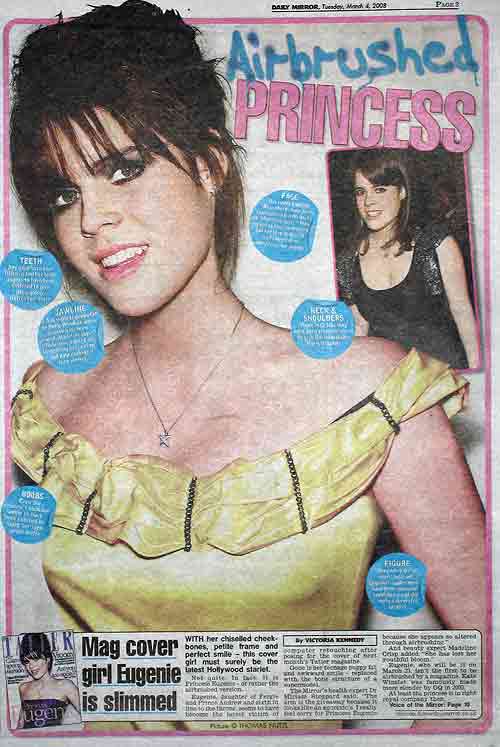1. Digital manipulation of photographs
by Tony Quinn
 |
||
| Royal victim: Prince William was 'enhanced' by Hello! magazine in February 2010 to look as if he had more hair – and that was well before his engagement to Kate Middleton | Regal controversy: Princess Eugenie, 6th in line to the throne, was 'touched up' in Photoshop for Tatler magazine. It was well covered by the press |
As these pages from two of Britain's best-selling newpapers show, digital manipulation of photographs is very common. 'Victims', willing and otherwise, include the royals Prince William and Princess Eugenie; actress Kate Winslet and Kelly Osbourne. 'Villains' include Hello!, Tatler and GQ magazines; and the Independent newspaper. Colour correction is routinely done on magazine covers and often the camera will be forced to tell a lie. However, as these pages will show, such manipulation is far older than Photoshop – it goes right the way back to the Victorian days of photography when plates and film were corrected in the darkroom using baths of chemical and fine brushes.
Contracts from some newspapers for photographers forbid certain practices and stipulate that images must be genuine. Techniques such as adding people, rearranging or moving objects or part of the scene are forbidden. The same is true for reversing images or distorting photographs. A similar code of practice will cover staff. Pictures will be cropped to focus in on part of an image, but even here, care has to be taken to ensure the ‘truth’ of the image is not distorted – the Magnum photo agency does not allow cropping of its pictures at all.The National Union of Journalists has a code of conduct which states that journalists should 'strive to ensure that information disseminated is honestly conveyed, accurate and fair'. Journalists should maintain the integrity of the content and context of photographic images, and avoid any manipulation in Photoshop that seeks to mislead people. If a photograph has been manipulated for some reason, it should be clearly labelled as such. Manipulation does not include normal dodging, burning, colour balancing, spotting, contrast adjustment, cropping and obvious masking for legal or safety reasons.
As we shall see, though, a very different set of values often pertains to fashion magazines – and their celebrity images are often picked up by the tabloid press.
Ultimately, two opposing points of view clash in a controversy that can end up on the front pages. One side holds that truth is vital (otherwise photojournalism cannot be trusted by its readers); and the other, that fashion photographers have always been in the business of creating beauty and perfection. In between, there may be another perspective: that such editing can serve to create a greater truth.
- Digital manipulation of photographs
- The photograph: proof of the truth
- Sherlock Holmes away with the fairies
- The power of photographs
- Rodchenko's deadly propoganda tricks
- Capa – the fall of an icon
- London Life: touching up photos
- Nova: causing a fuss in the swinging sixties
- Winslet and GQ: the debate today
- Eugenie and Tatler: look what they did to my heir
- Slick Economist cover attacked
- Where is photography going?
- Sources and Bibliography
Page 2: The photograph: proof of the truth




